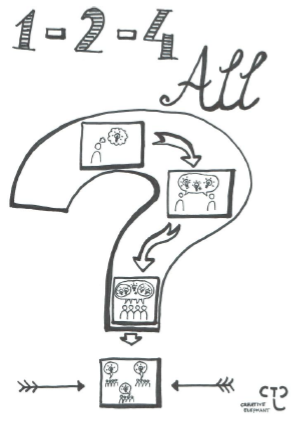
Facilitation
As a Scrum Master you will facilitate quite some meetings. How great would it be if all these meetings run smoothly with engaged participants. If you have a goal for your session that you also meet when the session is finished… on time. This category gives you tips and tricks for facilitating great sessions with engaged people and good outcomes
What is facilitation?
A great Scrum Master is able to facilitate an event that leads to a high-quality decision that is owned by the whole group attending that event. acts as a neutral party who doesn’t take sides or advocate their own agenda. Teams often have diverse knowledge, skills and experience that lead to many useful ideas, but not all ideas will be expressed and evaluated naturally. During a facilitated session the scrum master is driving towards fair, open, inclusive discussions, and decision making; ensuring there is space for all options to be shared and considered.
“Facilitation is defined as the act of making something easier or making something happen.”
Some general principles of good facilitation:
- Everyone participates
- Give people time to reflect
- Respect each other’s opinions
- Draw each other out by asking questions and paraphrasing
- Everyone is present and paying attention
- Create space for diverse opinions
- An agreement should represent a broad coalition of perspectives
Read more about facilitating Scrum Events.
A great Scrum Master can facilitate different types of meetings to keep people engaged. Try new things or shake up the meeting that has been facilitated the same way over and over again. Examples are: using magic estimation for a change instead of playing planning poker. Or use the Crazy 8 for a brainstorm session. Be creative!
1-2-4-All is an easy exercise to involve everyone of a group into a discussion. It is a proven technique to get a holistic view on a subject matter, to get new ideas and/or to share peoples perspectives to a group. 1-2-4-All requires little to no preparation.
It starts of with the facilitator asking the group a question or states a proposition. “How would you handle [x]?” Next, the question is discussed in the 1-2-4-All format:
- 1 minute alone,
- 2 minutes in pairs,
- 4 minuted in foursomes,
- 5 minutes with the whole group.
Read more on the website of Liberating Structures 1-2-4-All.

Metaplan
The Metaplan moderation method is a method for facilitating workshops aimed at creating mutual understanding, common goals and wide support on solutions.
During a Metaplan meeting the following are important:
- Visualisation of topics is important to keep the meeting fast-paced.
- Active involvement of all participants.
- Facilitator who leads discussions and controls the agenda.
Read all about Metaplan.
Game Based Learning
Game based learning or Gamification is the application of game-elements in non-gaming environment. Such as improving involvement of people or changing behaviour via rewards.
A great example is changing behaviour in the Daily Standup using the Daily Stand-up Game. Instead of the Scrum Master ‘schooling’ the developers, the developers play a game to recognize dysfunctional behavour themselves.
Other great recources are:
- Kahoot! Create a quiz to get to know each other, to explore peoples opinions on a topic, to gauge and share knowledge; possibilities are endless.
- Menitmeter: get instant feedback or opinions from participants to start discussions.
- TastyCupcakes: a website filled with exercises and techniques to help you facilitate.
- Jimmy cards: cards to start discussion of topics.
- Planning poker: gamified technique for estimation.
- Magic estimation: this little gem will give you estimations quickly and give you insights in what stories are not clear and need more discussion.
- Delegation poker: Start discussing where responsibilities are within the individuals, roles, teams and management.
Visualisation
When teaching material to students the average retention rates go up by 15% when using audio and visual material in a lecture. Visuals make the story you’re telling more attractive. They help in keeping the attention from your listeners and visuals help in remembering your story.
Read more about visual communitaction.
Read about: using visualisations when taking notess that tell a story.
25:10 Crowdsourcing
With this Liberating structure you can quickly generate and sift through a groups most powerful idea’s. Though it is fun, fast, and casual, it is a serious and valid way to generate an uncensored set of bold ideas and then to tap the wisdom of the whole group to identify the top ten.
Quick overview of the exercise:
- Every participant wirtes their idea on a card.
- Cards are passed around.
- When the facilitator calls, people pair up and exchange thoughts about the card in their hand.
- Participants rate the card in their hand 1 to 5 and write it on the back.
- Second round, cards get passed around again. Repeat process 5 times.
- Finally scores on the back are added up.
- The ideas with top 10 scores are shared with the group.
Try it out sometime and be amazed by the outcomes!
Also, check out Crazy 8.
UX Fishbowl
Fishbowls consist of an inside circle of people with direct experience with a challenge of interest to those in one or more outer circles. The inside circle shares experiences based around a common challenge while the outer circles listen. In alternating rounds, the outer circles generates questions they’d like to ask the inside circle. By focusing strongly on listening and asking questions about experiences, you can use UX Fishbowls to create an environment where people can learn together (rather than get solutions imposed on them).
How it works:
- Create an inside circle of chairs (3 to 7). Ask participants who’d like to share their experiences with the topic at hand to take a seat in the inside circle
- Invite the inside circle to have a conversation about a central question. (10-25 min)
- Invite the outer circle to form smaller groups (e.g. 2 to 4 people depending on how many people there are) and have them share observations and formulate BIG questions they’d like to have answered by the inside circle (5 min).
- Debrief using a different Liberating structure: What, So What, Now What?
View the exercise on Liberating structures.
Read about examples on how to use it with Scrum.
Decision Making Techniques
Quick decision making improves your sessions drastically. There are many ways to quickly come to a decision. Below are techniques that involve all participants in your session.
- Thumb-voting
- Dot-voting (e.g. used in Magic estimation. see: Game based learning)
- Fist of Five-voting
- Consent decision making
- ROTI (Return of Time Invested)
